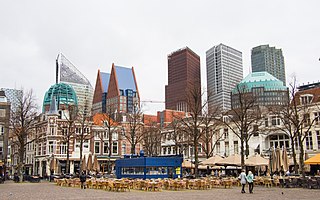
The Hague is the capital city of the South Holland province of the Netherlands. With a population of over half a million, it is the third-largest city in the Netherlands. Situated on the west coast facing the North Sea, The Hague is the country's administrative centre and its seat of government, and while the official capital of the Netherlands is Amsterdam, The Hague has been described as the country's de facto capital since the time of the Dutch Republic.
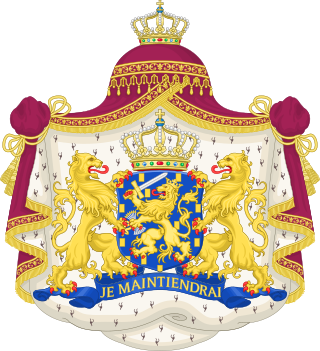
The House of Orange-Nassau is the current reigning house of the Netherlands. A branch of the European House of Nassau, the house has played a central role in the politics and government of the Netherlands and elsewhere in Europe, particularly since William the Silent organised the Dutch Revolt against Spanish rule, which after the Eighty Years' War (1568–1648) led to an independent Dutch state. William III of Orange led the resistance of the Netherlands and Europe to Louis XIV of France and orchestrated the Glorious Revolution in England that established parliamentary rule. Similarly, Queen Wilhelmina of the Netherlands was instrumental in the Dutch resistance during World War II.

Juliana was Queen of the Netherlands from 1948 until her abdication in 1980.
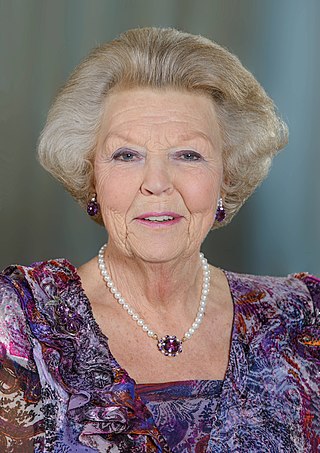
Beatrix is a member of the Dutch royal house who reigned as Queen of the Netherlands from 1980 until her abdication in 2013.

Máxima is Queen of the Netherlands as the wife of King Willem-Alexander.

Wilhelmina was Queen of the Netherlands from 1890 until her abdication in 1948. She reigned for nearly 58 years, making her the longest-reigning monarch in Dutch history, as well as the longest-reigning female monarch outside the United Kingdom. Her reign saw World War I, the Dutch economic crisis of 1933 and World War II.

Princess Christina of the Netherlands was the youngest of four daughters of Queen Juliana of the Netherlands and Prince Bernhard of Lippe-Biesterfeld. She taught singing in New York and was a long-term supporter of the Youth Music Foundation in the Netherlands. Born visually impaired, she worked to share her knowledge of dance and sound therapy with the blind.
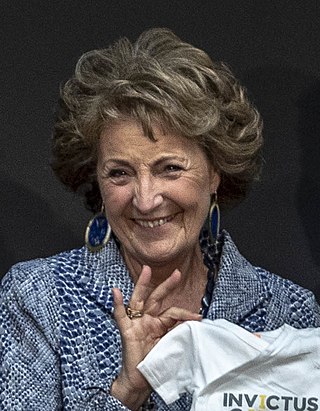
Princess Margriet of the Netherlands is the third daughter of Queen Juliana and Prince Bernhard. As an aunt of the reigning monarch, King Willem-Alexander, she is a member of the Dutch Royal House and currently eighth and last in the line of succession to the throne.

Catharina-Amalia, Princess of Orange is the heir apparent to the throne of the Kingdom of the Netherlands, which consists of the constituent countries of Aruba, Curaçao, the Netherlands, and Sint Maarten.

Noordeinde Palace is one of three official palaces of the Dutch royal family. Located in the city center of The Hague in the province of South Holland, it has been used as the official workplace of King Willem-Alexander and Queen Maxima since 2013. The Noordeinde Palace and its surrounding palace grounds are property of the Dutch State.

Huis ten Bosch is a royal palace in The Hague, Netherlands. It is one of three official residences of the Dutch monarch; the two others being the Noordeinde Palace in The Hague and the Royal Palace of Amsterdam.

Princess Alexia of the Netherlands, Princess of Orange-Nassau is the second daughter of King Willem-Alexander and Queen Máxima. Princess Alexia is a member of the Dutch royal house and second in the line of succession to the Dutch throne.

Prinsjesdag is the day on which the reigning monarch of the Netherlands addresses a joint session of the States-General of the Netherlands to give the Speech from the Throne, similar to the annual State of the Union in the United States or the British State Opening of Parliament. This speech sets out the main features of government policy for the coming parliamentary session.

Princess Ariane of the Netherlands, Princess of Orange-Nassau is the third and youngest daughter of King Willem-Alexander and Queen Máxima. Princess Ariane is a member of the Dutch Royal House and currently third in the line of succession to the Dutch throne.

Wilhelmine of Prussia was the first Queen consort of the Netherlands as the first wife of King William I of the Netherlands. She had a modest public role but acted as a patron of the arts.
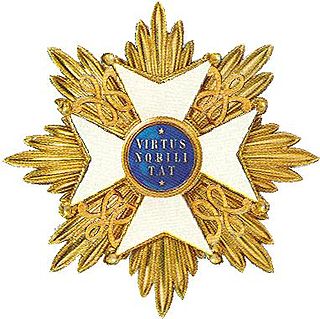
In the Dutch honours system, most orders are the responsibility of ministers of the Netherlands Government. The house orders, however, are awarded at the discretion of the Dutch monarch alone.

The monarchy of the Netherlands is governed by the country's constitution, roughly a third of which explains the mechanics of succession, accession, and abdication; the roles and duties of the monarch; the formalities of communication between the States General of the Netherlands; and the monarch's role in creating laws.

Koningsdag or King's Day is a national holiday in the Kingdom of the Netherlands. Celebrated on 27 April, the date marks the birth of King Willem-Alexander. When the Dutch monarch is female, the holiday is known as Koninginnedag or Queen's Day and, under Queen Beatrix until 2013, was celebrated on 30 April. She prolonged the tradition that was born under her mother’s reign: Queen Juliana’s birthday was on April 30th.

The Glass Coach is a royal carriage that was used by the Dutch royal family for special events before Queen Wilhelmina received the Golden Coach. The coach was then used only for the monarch or the parents of the bride or groom on a royal wedding day. In 2015, it started to be used more frequently for state events because the Golden Coach needed to be repaired. It is the oldest coach the Dutch royal family owns. The Glass Coach is stored at the Royal Stables in The Hague.
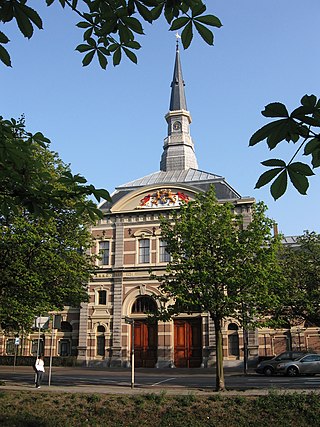
The Royal Stables is a collection of equestrian stables of the Dutch royal family, the House of Orange-Nassau. It is a Rijksmonumental building that is part of the royal palace grounds located in the city center of The Hague in the Netherlands. The Noordeinde Palace and the Palace Gardens are also part of this same palace complex. The Noordeinde Palace and its grounds are the official workplace of the Dutch King Willem-Alexander.




















